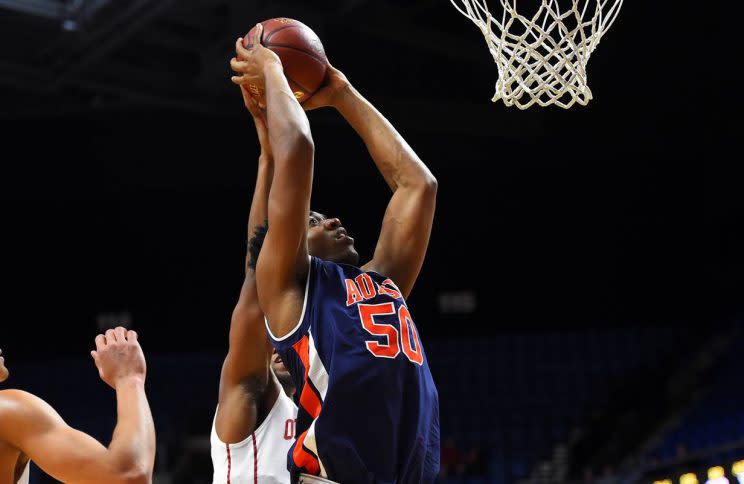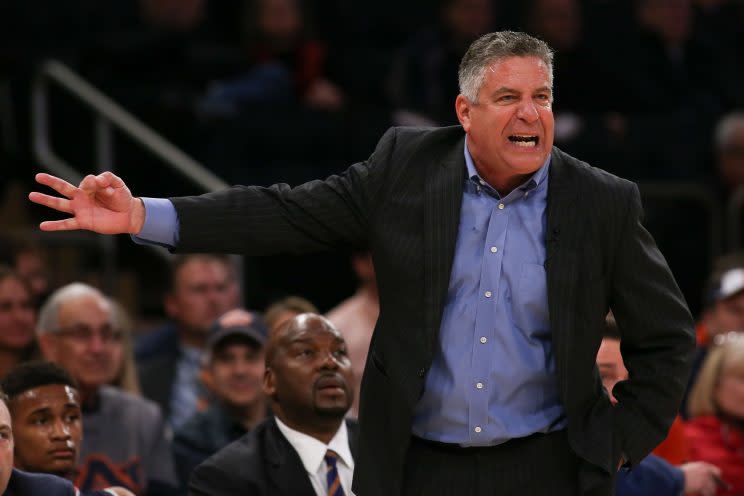Did Austin Wiley and Auburn introduce basketball to the one-and-a-half-and-done?

When the NCAA contacted Auburn last Thursday to notify the school that it had deemed Austin Wiley eligible to join the Tigers’ basketball program immediately, logistical gears spun into overdrive.
Wiley, a 17-year-old five-star recruit who was originally slated to matriculate with Auburn’s 2017 recruiting class next summer, set out for campus and arrived in time to catch the Tigers’ 117-72 win over Coastal Carolina. The following day, he was officially admitted to school, and registered for the spring semester. He underwent physicals. Administrators, meanwhile, awaited word from the SEC as the conference completed its own review of Wiley’s eligibility.
In the afternoon, word came, and Wiley’s whirlwind day accelerated onto the basketball court, where he officially practiced with his new teammates for the first time. Auburn coach Bruce Pearl spent around two hours walking Wiley through the fundamentals of his transition offense. Assistant coach Chuck Person then took the 6-foot-10 center through the basics of the team’s defense.
Fewer than 48 hours later, with about 10 percent of the playbook flimsily hanging from his metaphorical back pocket, Wiley — less than a month removed from the first semester of his senior year of high school — scored nine points in 15 minutes in Auburn’s 76-74 victory over Mercer.
And then, finally, maybe, he got to savor a few deep breaths.
If Wiley’s timeline — graduating high school in three-and-a-half years, enrolling in college and jumping right onto the court for the latter three months of the season — seems out of the ordinary, that’s because it is. It’s almost unprecedented. And it prompts plenty of “whys.” Why would a kid choose to go through such a wild transition? Why would he waste a year of eligibility on half a season? And why is this even permitted?
In fact, when the possibility was brought to Wiley’s attention last spring, he was “blown away.” His initial reaction:
Wow, I could really do this?
Wiley was hesitant. “At first I wasn’t really on board with it,” he said Tuesday in a telephone interview. “Because I had to give up a lot. I had to give up the possible McDonald’s All American game, the possible Hoop Summit game, the possible Jordan Brand Classic game.” In order to graduate in three-and-a-half years, he also had to forgo his senior year at Spain Park High School and transfer to a Florida prep school so he could take summer classes.
But in discussions with his parents — both basketball standouts at Auburn themselves — and with Pearl and his staff, the rationale blossomed. Wiley, whom Pearl calls “a legitimate one-and-done candidate,” has NBA aspirations. However, regardless of the date of his high school graduation, Wiley, who was born in 1999, won’t be draft-eligible until 2018. By enrolling early, Wiley extended his stay at Auburn from 10 months to 15 at minimum, and expanded the cushion between high school and the pros — a cushion many, including NBA commissioner Adam Silver, believe is too thin.
In doing so, Wiley introduced college basketball to what he, Pearl, and and the director of Wiley’s Alabama AAU program, Jerry Bartley, all believe will be a path explored by other top high school prospects in years to come: the one-and-a-half-and-done.
“I do think that this is something that others should look into,” Pearl says. “Because it gives [players] more time to make that transition from high school to college, and then to the professional ranks. The way that we train, the coaching, the competition, all those things are gonna help him have a better second year in college, and a better first year in the professionals.”
Bartley also points out that players who might potentially be impeded by the NCAA’s academic eligibility requirements can use the summer classes to improve their grades.
For schools, the incentive is clear. If a player is unlikely to stay for four years, why not add a five-star prospect out of nowhere heading into conference play? Pearl admitted that trying to get Wiley acclimated before the Mercer game “was clearly disruptive in our preparation in the short term, but obviously in the long term it’s going to pay off.”

While Wiley’s move is uncommon, it isn’t completely unprecedented. Jarnell Stokes made a similar one when he enrolled at Tennessee in January 2012 after being ruled ineligible for his senior year of high school. NC State freshman Dennis Smith enrolled last January, but not to play; Smith was recovering from summer ACL surgery, and chose to graduate high school early to have the final stages of his rehab overseen by the Wolfpack’s medical staff.
And then there are football players, who do this all the time — they just don’t have a season that engulfs them right away. Instead, they come for spring practice, with the knowledge that an extra five or six months in the program will improve their chances to see the field as true freshmen, and perhaps augment their NFL draft stock three years later.
The widest gap in the comparison between football and basketball, and the biggest downside for basketball December enrollees, is that joining a basketball program mid-season turns four years of eligibility into three-and-a-half. If Wiley were to underwhelm at Auburn and receive lukewarm evaluations from NBA scouts, he may decide to see out his time in college. In that scenario, the early enrollment would backfire.
Plus, even for those who are surefire lottery picks, the early enrollment isn’t for everyone. Wiley understands that. “Some people need that last year of high school,” he says. “You never know how somebody’s going to feel. They could have a smile on their face, but they get to the next level, and they get dunked on the first day of practice, and their confidence level could just go down the drain.”
It’s a big commitment too. Wiley left a lot of good friends at Spain Park High, and there were times when he contemplated the expedited curriculum and thought, Man, this is hard. In fact, one of the reasons Pearl kept quiet on Wiley’s plan to graduate early was that, frankly, he wasn’t sure Wiley could do it.
For some, there also could be eligibility concerns. Wiley actually graduated high school weeks ago, but was forced to delay his enrollment while the NCAA conducted a thorough examination to ensure he was a qualifier. (If he hadn’t been, Wiley could have played out his senior season at Conrad Academy in Florida.)
On top of all that, there’s the challenge of learning playbooks and schemes on the fly during the heat of conference play. Pearl and his staff weren’t allowed to involve Wiley in any team activities until he was officially a part of their program. Pearl said Tuesday that he hoped Wiley would have a grasp on 20 percent of the playbook by Wednesday’s game against Oklahoma, a 74-70 win, and maybe 25 percent by tipoff of Friday’s game against UConn. Playing against 20- and 21-year-olds as a 17-year-old with a schematic disadvantage is no easy task.
But if that task isn’t overwhelming, and the one-and-done plans are all but set in stone, why not opt for a one-and-a-half-and-done?
Other five-star recruits will at least ponder the question. And after Wiley paved the way, they might just follow.

 Yahoo Sports
Yahoo Sports 

